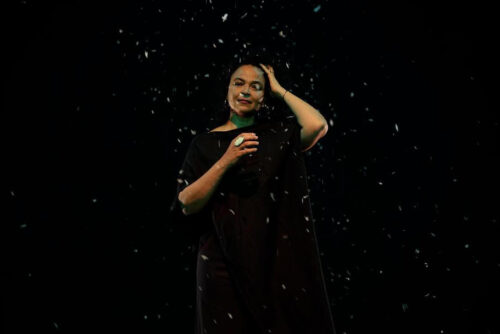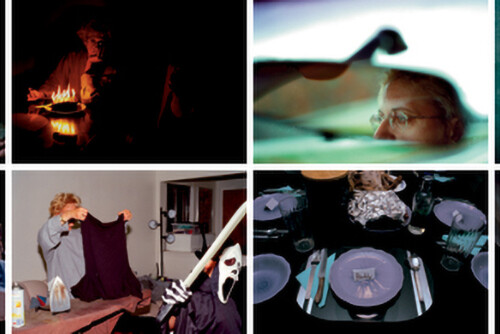“To Make Visible Everywhere: Our Bold, Beautiful, Aging Bodies” is a collection of personal reflections, performances, research journeys, and conversations by and about women of color aging. This special issue of The Scholar and Feminist Online was guest edited by choreographer, filmmaker, educator, and curator Gabri Christa and media studies scholar Sheril Antonio. Together, these pieces evoke a scene one might find at a community gathering with the voices of many women joined in a room speaking frankly about the physical, intellectual, and emotional shifts that accompany the process of getting older.
Confronting topics that have been at the center of feminist scholarship in aging studies, media studies, and disability studies, these contributions reveal the many gaps that still exist in the scholarly treatment and artistic representation of older and aging women of color. Some of our writers observe aging from some distance, from the position of caretaker, witness, or inheritor of a legacy. Others explore their own journey from youth to eldership through self-inquiry and compassion. Others explore their own journey from youth to eldership through self-inquiry and compassion. The result is a body of texts, film, photography, and choreography that answers the guest editors’ call to make visible lives that have been denied representation and acknowledgement. While editing this work, we found inspiration to revere the women we know, trans, cis, femme, masc, and non-binary, who resist erasure through the life paths and expression they fashion for themselves, though we may never see them on TV.
On the edges of these pieces, we recognize contextual issues shaping the concerns at the heart: the shift in social value birthing people experience once they are no longer of reproductive age, the increased proximity of women of color to death and loss during the COVID-19 pandemic, or how so many women of color continue to carry the labor of familial caretaking while also working to support themselves past an ideal retirement age. Although many of the contributors’ personal narratives do not wrestle these questions directly, they speak poignantly as artists, movement practitioners, and scholars about how to build lives around creativity and self-actualization while resisting hegemonic social norms. Their works emulate the celebration Lucille Clifton calls for in her poem “won’t you celebrate with me”:
won't you celebrate with me
what i have shaped into
a kind of life? i had no model.
born in babylon
both nonwhite and woman
what did i see to be except myself?1
In the introduction, Gabri Christa juxtaposes media images that construct aging women as a problem to be solved against the inspiration she gleaned from real-life women who shaped her career as a dancer, choreographer, and filmmaker. Tria Blu Wakpa’s essay examines how individual movement practitioners seek new paradigms within yoga and dance for affirmation and self-discovery that resist heteronormativity and white supremacy. Maura Donohue shares a lively cross-generational interview with three stage performers who navigate body-shaming, coercion, and power to portray Euro-canonical archetypes Helen of Troy and Cassandra on stage. Diedra Harris-Kelley’s essay reflects on aging through the lives of her mother and two aunts, one of whom was Sheila Rohan, a leading ballerina in Dance Theatre of Harlem, who taught dance and performed into her eighties. One of Christa’s experimental documentary films in the issue also pays tribute to Rohan.
Photographer Deborah Willis’s images meditate on the hands of elders who have carried communities, while Andrea E. Woods Valdés prose traces her mother and father’s presence in her own hands and feet. A stunning photo essay by Khadija Benn, with introduction by Grace Aneiza Ali, reminds us that elder women who are left behind when family members migrate continue to play a crucial role in bridging distance and maintaining community ties across borders. Co-editor Sheril Antonio reconstructs the Black matriarch archetype in film and television in an essay celebrating Cicely Tyson’s complex portrayal of Ophelia Harkness in How to Get Away With Murder. Sisters Sandhiya and Srisrividhiya Kalyanasundaram share a poignant profile of their mother Saraswati’s devotional music practice, and Sumedha Bhattacharyya’s video and essay answer a provocation from daughter to mother: “What do you think of aging, not about it?” LaTasha Diggs’s irreverent poetic commentary in “Disappearing Acts @ 50” appears in both text and video, featuring dancer Esraa Warda, to highlight the ironic joy in survival. And finally, Gabri Christa’s short film Sajda closes this issue with an ecstatic performance by the late dancer Sajda Musawwir Ladner, who transitioned in 2021, leaving a celebrated legacy of arts education and joie de vivre in her Staten Island community. While each of these pieces in some way reminds us of the relationship between aging and mortality, we are called to celebrate all that endures.
We note that while the authors attempted to grapple with the imprint of racism and ageism on their own lives and identities, the contributed writing sometimes veers into unexamined ableism, sizeism, class blindness, cultural essentialism, and othering. We have chosen to edit and publish these pieces with fidelity to the contributors’ voice and experience.
Works Cited
Clifton, Lucille. “won’t you celebrate with me,” in Book of Light. Copper Canyon Press, 1993.
- Lucille Clifton, “won't you celebrate with me,” Book of Light (Copper Canyon Press, 1993). [↩]



